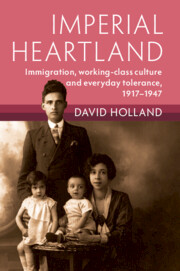Book contents
- Imperial Heartland
- Modern British Histories
- Imperial Heartland
- Copyright page
- Dedication
- Epigraph
- Contents
- Figures
- Maps
- Acknowledgements
- Abbreviations
- Introduction
- 1 Sheffield, ‘Steel City’
- 2 The Sheffield Area’s South Asian Migration Networks
- 3 Working Lives
- 4 Marriage, Belonging and Tolerance in the Era of Moral Condemnation
- 5 Empire, Racism and Everyday Tolerance
- Conclusion
- Bibliography
- Index
4 - Marriage, Belonging and Tolerance in the Era of Moral Condemnation
Published online by Cambridge University Press: 03 August 2023
- Imperial Heartland
- Modern British Histories
- Imperial Heartland
- Copyright page
- Dedication
- Epigraph
- Contents
- Figures
- Maps
- Acknowledgements
- Abbreviations
- Introduction
- 1 Sheffield, ‘Steel City’
- 2 The Sheffield Area’s South Asian Migration Networks
- 3 Working Lives
- 4 Marriage, Belonging and Tolerance in the Era of Moral Condemnation
- 5 Empire, Racism and Everyday Tolerance
- Conclusion
- Bibliography
- Index
Summary
The ’inter-racial’ or ‘mixed’ marriage should be, Chapter 4 argues, central to discussion of South Asian immigration to Britain in the first half of the twentieth century. The chapter examines evidence from the marriage records and argues that the role and widespread distribution of mixed marriages across Britain have been neglected by historians. It explores the backgrounds and social position of women who entered into relationships with South Asian men and questions J. B. Priestley’s assertion that mixed working-class couples were formed from ‘the riff-raff of the stokeholds and the slatterns of the slums’. Couples in mixed marriages have also been presented by historians as isolated from the neighbourhoods they inhabited. This chapter, however, argues that these couples were often thoroughly integrated into their neighbourhoods and maintained frequent contact not just with close friends, but also with blood relations, in-laws and neighbours. Additionally, these marriages, and the families and households they formed, played a significant, if not crucial, role in acting as anchor points in enduring chains of migration spanning the inter-war period and into post-Partition era.
Keywords
- Type
- Chapter
- Information
- Imperial HeartlandImmigration, Working-class Culture and Everyday Tolerance, 1917–1947, pp. 162 - 248Publisher: Cambridge University PressPrint publication year: 2023

